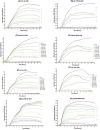Increased susceptibility to azithromycin of Pseudomonas aeruginosa biofilms using RPMI 1640 testing media
- PMID: 38622982
- PMCID: PMC11582341
- DOI: 10.1111/apm.13413
Increased susceptibility to azithromycin of Pseudomonas aeruginosa biofilms using RPMI 1640 testing media
Abstract
Azithromycin (AZM) is efficient for treatment of chronic Pseudomonas aeruginosa biofilm lung infections, despite of resistance in conventional susceptibility testing. It has been shown that planktonic P. aeruginosa are more susceptible to AZM when tested in RPMI 1640 medium. The aim of the study was to test the susceptibility to AZM of P. aeruginosa biofilms in LB vs RPMI 1640 media. We investigated the effect of AZM on planktonic and biofilms of (WT) P. aeruginosa (PAO1), the hypermutable (ΔmutS) and the antibiotic-resistant phenotype(ΔnfxB) mutants. The effect of AZM on young and mature biofilms was investigated in the modified Calgary Biofilm Device by estimation of the minimal biofilm inhibitory concentration (MBIC). The AZM MBIC90 in LB/RPMI1640 on young biofilms treated for 24 h was 16/4 μg/mL for PAO1, 32/8 μg/mL for ΔmutS, and 256/16 μg/mL for ΔnfxB, while in mature biofilms was 256/2 μg/mL for PAO1 and ΔmutS and 16/1 μg/mL for ΔnfxB. The effect of AZM was improved when the treatment was prolonged to 72 h, supporting the intracellular accumulation of AZM. An increased susceptibility of P. aeruginosa biofilms to AZM was observed in RPMI 1640 than in LB medium. Our results might improve susceptibility testing and dosing of AZM for treatment of biofilm infections.
Keywords: Pseudomonas aeruginosa; RPMI‐1640; azithromycin; biofilm.
© 2024 The Authors. APMIS published by John Wiley & Sons Ltd on behalf of Scandinavian Societies for Pathology, Medical Microbiology and Immunology.
Figures




Similar articles
-
Molecular basis of azithromycin-resistant Pseudomonas aeruginosa biofilms.Antimicrob Agents Chemother. 2005 Sep;49(9):3858-67. doi: 10.1128/AAC.49.9.3858-3867.2005. Antimicrob Agents Chemother. 2005. PMID: 16127063 Free PMC article.
-
Azithromycin retards Pseudomonas aeruginosa biofilm formation.J Clin Microbiol. 2004 Dec;42(12):5842-5. doi: 10.1128/JCM.42.12.5842-5845.2004. J Clin Microbiol. 2004. PMID: 15583321 Free PMC article.
-
Azithromycin in Pseudomonas aeruginosa biofilms: bactericidal activity and selection of nfxB mutants.Antimicrob Agents Chemother. 2009 Apr;53(4):1552-60. doi: 10.1128/AAC.01264-08. Epub 2009 Feb 2. Antimicrob Agents Chemother. 2009. PMID: 19188376 Free PMC article.
-
The microenvironment in antibiotic susceptibility testing.APMIS. 2024 Dec;132(12):985-991. doi: 10.1111/apm.13405. Epub 2024 Apr 2. APMIS. 2024. PMID: 38565324 Review.
-
Standard versus biofilm antimicrobial susceptibility testing to guide antibiotic therapy in cystic fibrosis.Cochrane Database Syst Rev. 2020 Jun 10;6(6):CD009528. doi: 10.1002/14651858.CD009528.pub5. Cochrane Database Syst Rev. 2020. PMID: 32520436 Free PMC article.
Cited by
-
Corticosteroids modulate biofilm formation and virulence of Pseudomonas aeruginosa.Biofilm. 2025 May 29;9:100289. doi: 10.1016/j.bioflm.2025.100289. eCollection 2025 Jun. Biofilm. 2025. PMID: 40539031 Free PMC article.
-
Menadione as Antibiotic Adjuvant Against P. aeruginosa: Mechanism of Action, Efficacy and Safety.Antibiotics (Basel). 2025 Feb 7;14(2):163. doi: 10.3390/antibiotics14020163. Antibiotics (Basel). 2025. PMID: 40001407 Free PMC article.
References
-
- Saiman L, Marshall BC, Mayer‐Hamblett N, Burns JL, Quittner AL, Cibene DA, et al. Azithromycin in patients with cystic fibrosis chronically infected with Pseudomonas aeruginosa: a randomized controlled trial. JAMA. 2003;290:1749–1756. - PubMed
-
- Altenburg J, de Graaff CS, Stienstra Y, Sloos JH, van Haren EHJ, Koppers RJH, et al. Effect of azithromycin maintenance treatment on infectious exacerbations among patients with non‐cystic fibrosis bronchiectasis: the BAT randomized controlled trial. JAMA. 2013;309:1251–1259. - PubMed
-
- Jaffe A, Bush A. Anti‐inflammatory effects of macrolides in lung disease. Pediatr Pulmonol. 2001;31:464–473. - PubMed
MeSH terms
Substances
LinkOut - more resources
Full Text Sources
Medical

